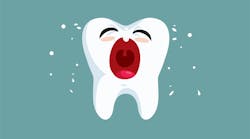Clinical study explores efficacy of light-activated therapy in adolescents undergoing orthodontic treatment
A clinical study, “Efficacy of Regular Home Use of Dual-Light Photodynamic Therapy on Oral Health in Adolescents Undergoing Fixed Orthodontic Treatment,” is underway at Borgska Villan’s Specialist Dental Care clinic in Lund, Sweden. The so-called “clean-bracket study” evaluates the effectiveness of the antibacterial Lumoral method (developed by Finnish scientists but not yet available in the US) in improving oral health for teenagers with fixed braces.1
The study, led by Dr. Ann-Marie Roos Jansåker, associate professor at the department of periodontology, Malmö University, and former president of the Swedish Society of Periodontology and Implantology, in collaboration with Dr. Katja Elses, specialist in orthodontics, focuses on determining whether regular use of the light-activated teeth cleaning method can help reduce plaque buildup and prevent gingival inflammation and caries, common issues faced by individuals with braces.
“The study investigates how antibacterial treatment can improve oral health in adolescents with fixed braces, which often complicate oral hygiene and hereby risk of both caries and gingival inflammation. This study is designed to provide robust data on whether regular use of light-activated Lumoral therapy can mitigate these risks,” explains Mikko Kylmänen, clinical project manager at Koite Health Ltd., the company behind the antibacterial Lumoral innovation.
According to Mr. Kylmänen, the trial received ethical approval in April 2023 and permission from Läkemedelsverket (the Swedish Medical Products Agency) in June 2023. It began enrolling its first patients in November 2023.
In a clinical study with 40 subjects undergoing orthodontic treatment, participants are randomized into either the Lumoral treatment group or a control group. Over 12 weeks, clinical measurements such as visible plaque index (VPI), bleeding on probing (BOP), and orthodontic plaque index (OPI) are assessed, alongside microbiological analyses to evaluate the device’s effectiveness. The clinical measurements during the follow-up visit at 12 weeks are blinded so that the investigator does not know whether a participant is receiving antibacterial treatment.
A tool for eliminating problem-causing bacteria
The clean-bracket study, led by Dr. Roos Jansåker, focuses on adolescents aged 15 to 18 undergoing orthodontic treatment—a group particularly susceptible to plaque buildup and gingival inflammation due to the difficulties associated with fixed braces. The trial aims to determine whether light-activated antibacterial treatment, when used in addition to brushing and flossing, can enhance dental plaque control and help manage plaque over time. The antibacterial Lumoral device may also have a photobiomodulation (PBM) effect, potentially benefiting the health of periodontal tissues.
PBM is a noninvasive therapy that has demonstrated positive effects in neurosensory recovery, treating musculoskeletal injuries and degenerative diseases, and promoting healing in regenerative medicine and dentistry. In dentistry, PBM enhances cellular activity, aiding bone regeneration and stimulating soft tissues. It improves wound healing, reduces postoperative pain, and enhances periodontal treatment outcomes, improving patient comfort and efficacy. Despite its potential, its use in dentistry has been limited.2,3
Research in PBM has increased rapidly in recent years, with a growing focus on low-level laser therapy and new technologies such as laser diodes in dentistry. The field has evolved—from early topics such as aiding in the healing of dentin and surrounding tissues and improving outcomes in dental treatments (such as cavity fillings) or root canal therapy, to more complex treatments such as tissue regeneration and cell therapy using dental pulp stem cells. New research areas, including the detection of early-stage caries, are emerging rapidly. These lasers can identify changes in tooth structure by measuring how light interacts with enamel and dentin, helping detect caries early.
PBM is a therapeutic process that uses light—typically low-level lasers or LEDs—to stimulate cellular function, promote healing, reduce inflammation, and alleviate pain. PBM delivers specific wavelengths of light to cells, which are absorbed by mitochondria (the energy-producing structures within cells). This absorption increases cellular energy production (ATP), enhancing tissue repair and regeneration.2,3
Braces and oral hygiene: Addressing the challenges and risks
Dr. Roos Jansåker highlights that while orthodontic treatment is common for children and adolescents, fixed appliances, such as braces, can make it challenging to maintain proper oral hygiene. This difficulty often leads to plaque buildup around the braces, increasing the risk of initial tooth decay (caries) and gingivitis.
A Japanese study examining 71 patients of unspecified ages found that fixed braces alter the oral microbiome by increasing harmful bacteria associated with gum diseases. This bacterial imbalance suggests that braces might even predispose individuals to more severe gum issues, such as periodontitis.4
“Orthodontic treatments, such as braces, are essential for correcting dental alignment in teenagers, but they also have certain risks that should be addressed. We hope to demonstrate that regular antibacterial treatment can significantly benefit adolescents wearing fixed orthodontic appliances,” Dr. Roos Jansåker said.
According to the associate professor, one of the most significant risks associated with braces is caries development. “This is particularly concerning for teenagers who often consume a lot of sugary drinks like Coca-Cola and eat candy, and their oral hygiene practices might not be as rigorous as needed, increasing the likelihood of caries development.”
While more severe periodontal problems, such as periodontitis (which involves the breakdown of bone around the teeth), are uncommon in teenagers, Dr. Roos Jansåker stressed that gingivitis is a frequent issue. “Gingivitis is a superficial inflammation of the gums caused by dental plaque buildup, and it is prevalent among teens with braces. Teenagers mustn’t have gingivitis before getting braces because it can worsen during treatment. This is why maintaining healthy gums is important before starting orthodontic treatment.”
Another significant problem associated with braces is the development of white spots on the teeth. These white areas on tooth enamel, which appear when the braces are removed, result from plaque buildup that leads to enamel demineralization due to acid exposure.5
“This is a serious concern because these spots can be permanent and affect the appearance of the teeth,” Dr. Roos Jansåker explained.
Antibacterial treatment for enhanced oral health
Lumoral is a CE-marked medical device recommended by the Finnish Association of Dental Hygienists. It is designed to improve oral health by targeting and reducing harmful bacterial plaque through its light-activated antibacterial technology. The device utilizes antibacterial blue and red light and a photosensitive Lumorinse mouth rinse to eliminate harmful dental plaque bacteria and reduce plaque buildup. It is particularly beneficial for individuals with orthodontic appliances, gum disease, or those prone to plaque-related oral issues, such as cavities and gum disease.
Development of this new oral health-enhancing method was driven by recognizing the limitations of traditional oral hygiene practices in effectively controlling plaque and preventing diseases such as periodontitis and dental caries. The treatment complements brushing and flossing rather than replacing these essential mechanical oral hygiene methods.6,7
“If a device like Lumoral can demonstrate its effectiveness in reducing plaque around braces, it could be an excellent tool to minimize these risks. The results from follow-up checks, especially at the three-month mark, are crucial in assessing the device’s impact on plaque control. Consistent monitoring and good oral hygiene practices are essential to prevent these common issues associated with orthodontic treatment,” Dr. Roos Jansåker pointed out.
“We are excited to see the final results of this trial, as it represents a step forward in improving oral care practices for adolescents. Preliminary findings have shown promising results regarding plaque reduction and inflammation control, and we are hopeful that this study will validate Lumoral as a valuable tool for orthodontic patients,” said Koite Health’s Mikko Kylmänen.
The results of the clean-bracket trial are expected in early spring 2025.
In brief: The clean-bracket study
A total of 40 participants are enrolled in the randomized, controlled trial, split into two groups: 20 subjects receiving Lumoral treatment and 20 in the control group. All subjects must provide signed consent, with parental consent needed for minors.
The study protocol includes several essential visits as part of the participants’ routine dental care:
Pretreatment visit: screening with inclusion and exclusion criteria and informed consent
Baseline visit: baseline assessments, randomization, and the start of the intervention, including professional cleaning of teeth and fixed braces attachment
Follow-up visit: scheduled at 12 weeks postbaseline
Each visit—lasting between 45 and 60 minutes—ensures careful monitoring of participants’ oral health and the efficacy of the treatment.
In line with rigorous clinical standards, investigator Dr. Ann-Marie Roos Jansåker is “blinded,” meaning she is unaware of which group each study participant belongs to, ensuring unbiased assessments throughout the trial.
The last patient’s visit is expected to occur in the autumn of 2024, and the trial’s final results are anticipated in the early spring of 2025. Koite Health, a company specializing in innovative oral health solutions, is sponsoring the study.
As orthodontic treatment in adolescents can complicate daily oral hygiene, the clean-bracket study could provide valuable insights into new approaches for maintaining oral health in this vulnerable group. If successful, the Lumoral method could become a vital tool in enhancing plaque control and reducing gum inflammation in patients with braces.
Editor’s note: This article first appeared in Clinical Insights newsletter, a publication of the Endeavor Business Media Dental Group. Read more articles and subscribe.
References
- Clinical trial September 4, 2023–December 30, 2025 in Sweden. Efficacy of regular home use of dual-light photodynamic therapy on oral health in adolescents undergoing fixed orthodontic treatment – randomized, controlled clinical study. Esperity. https://clinicaltrial.be/en/details/265810
- Rodriguez Salazar DY, Málaga Rivera JA, Laynes Effio JE, Valencia-Arias A. A systematic review of trends in photobiomodulation in dentistry between 2018 and 2022: advances and investigative agenda. F1000Res. 2023;12:1415. doi:10.12688/f1000research.140950.2
- Dompe C, Moncrieff L, Matys J, et al. Photobiomodulation–underlying mechanism and clinical applications. J Clin Med. 2020;9(6):1724. doi:10.3390/jcm9061724
- Kado I, Hisatsune J, Tsuruda K, Tanimoto K, Sugai M. The impact of fixed orthodontic appliances on oral microbiome dynamics in Japanese patients. Sci Rep. 2020;10(1):21989. doi:10.1038/s41598-020-78971-2
- Schulz SM, Yáñez NY. Dental caries during orthodontic treatment: a review of the literature. MOJ Orthop Rheumatol. 2022;14(6):176-180. doi:15406/mojor.2022.14.00603
- The Finnish Oral Hygiene Association recommends Lumoral. Finnish Association of Dental Hygienists. September 1, 2022. https://www.suuhygienistiliitto.fi/suomen-suuhygienistiliitto-suosittelee-lumoralia/
- Pakarinen S, Saarela RKT, Välimaa H, et al. Home-applied dual-light photodynamic therapy in the treatment of stable chronic periodontitis (HOPE-CP)—three-month interim results. Dent J (Basel). 2022;10(11):206. doi:10.3390/dj10110206
About the Author

Nina Garlo-Melkas, MSc
Nina Garlo-Melkas, MSc, is a health and science journalist.






